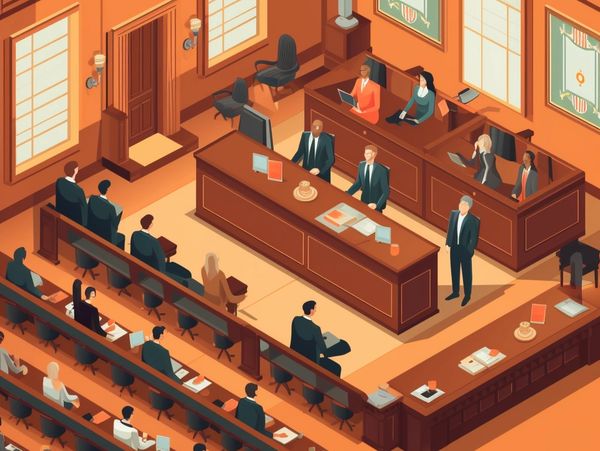Accomplishing Success in Courtroom Trials: The Significance of Expert Trial Presentations
Navigating the Intricacies of Trial Presentations: Tips for Seamless Delivery and Engaging Arguments
In the world of legal procedures, the art of trial discussion stands as an essential determinant of success. The complexities fundamental in trial presentations require a delicate balance of approach, skill, and ability.

Recognizing Test Objectives
To efficiently browse a test, it is important to have a clear understanding of the purposes that need to be accomplished. Prior to tipping into the courtroom, legal teams need to define their goals and preferred results. These purposes function as assisting concepts throughout the test, forming strategies and influencing decision-making processes.
Comprehending trial goals includes a detailed evaluation of the instance, lawful criteria, and the customer's benefits. Trial Presentations. It calls for a careful examination of the truths, identifying vital concerns, and expecting potential difficulties. By setting specific and quantifiable goals, lawyers can customize their disagreements and presentations to line up with the desired results
Moreover, a clear grasp of test goals allows legal teams to focus on proof, witnesses, and legal arguments properly. It enables the advancement of a systematic narrative that reverberates with the discretionary, strengthening the total situation presentation.

Organizing Proof Properly
Having a clear understanding of test objectives lays the structure for organizing evidence effectively in lawful process. By lining up the presentation of evidence with the wanted results of the trial, lawful teams can enhance their arguments and enhance their persuasiveness.
An additional crucial element in arranging evidence successfully is establishing a rational flow. Providing proof in a sequential and systematic manner can aid build an engaging narrative that supports the lawful arguments being made. Furthermore, making use of visual help such as charts, timelines, or charts can better enhance the company of proof and assist in clearing up intricate connections or sequences of occasions.
Moreover, ensuring that all evidence provided is permissible and relevant to the instance is important. Pointless or inadmissible evidence can detract from the stamina of the argument and possibly damage the credibility of the providing celebration. Consequently, a meticulous review and choice process must be taken on to consist of only the most impactful and lawfully sound evidence in the trial presentation.
Crafting Persuasive Narratives
Crafting engaging narratives plays a pivotal duty in presenting influential disagreements during lawful proceedings. When creating a narrative for a test presentation, it is essential to develop a clear storyline that highlights crucial points and attaches them in a coherent manner. By weaving with each other evidence, testament, and legal disagreements into a convincing and natural narrative, lawful professionals can successfully advocate for their customers and raise the possibility of a favorable result in the court room.
Grasping Aesthetic Help
Effective usage of aesthetic aids is crucial to boosting the impact and clearness of test discussions. Visual help, when site link utilized tactically, have the power to simplify complex information, reinforce bottom lines, and leave a long lasting perception on the court and court. To grasp aesthetic help in trial discussions, it is crucial to guarantee that they are clear, succinct, and pertinent to the arguments being made.
When incorporating visual aids, such as graphes, photographs, graphs, or timelines, into a trial discussion, it is necessary to maintain them visually appealing yet professional. The visuals should complement the verbal debates, giving a graph of the information being discussed without overwhelming the target market with unneeded information.
In addition, experimenting the aesthetic help in advance is critical to ensure a smooth distribution throughout the test. Acquainting oneself with the material, shifts, and timings of each visual help can aid keep the circulation of the presentation and avoid technical problems that might develop.
Providing Impactful Closing Arguments
An engaging closing argument offers as the culmination of a test presentation, enveloping the core story and convincing the court and jury in the direction of a beneficial choice. Begin by outlining the major arguments that sustain your customer's placement, emphasizing why the proof offered throughout the trial sustains your story.
Additionally, including emotional allure can further enhance your closing debate. By connecting and humanizing the situation on an individual level with the decision-makers, you can evoke compassion and understanding, affecting their perception of the truths offered. Additionally, repeating the lawful standards that have to be met for a positive judgment can reinforce the validity of your setting. Inevitably, a well-crafted closing argument ought to leave an enduring impact, compelling the discretionary to rule in your client's support.
Final Thought
To conclude, understanding test discussions entails recognizing purposes, arranging proof, crafting stories, using visual aids, and delivering impactful closing debates. By executing these strategies successfully, lawyers can offer their case flawlessly and make compelling debates in the court. It is critical to browse the intricacies of test discussions with precision and ability to attain success in lawful procedures.
By straightening the discussion of proof with the preferred results of the test, lawful teams can strengthen their arguments and improve their persuasiveness (Trial Presentations). To master visual aids in test discussions, it is essential to make certain that they are clear, succinct, and relevant to the debates being made
An engaging This Site closing argument offers as the end result of a test discussion, encapsulating the core narrative and convincing the judge click to find out more and jury in the direction of a favorable decision. Begin by outlining the primary disagreements that support your client's placement, stressing why the evidence presented throughout the test supports your story.In conclusion, understanding trial discussions includes understanding purposes, organizing evidence, crafting narratives, making use of visual aids, and supplying impactful closing arguments.